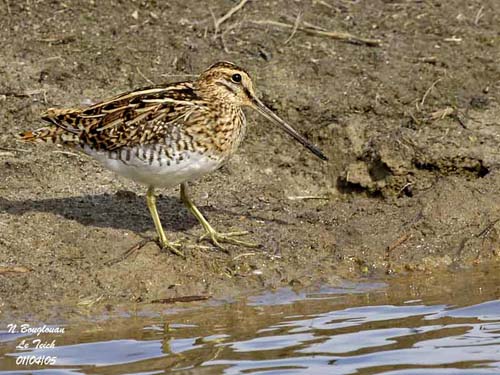
Common Snipe
Gallinago gallinago
Charadriiforme Order – Scolopacidae Family
BIOMETRICS:
Length: 25-27 cm
Wingspan: 44-47 cm
Weight: 72-181 g
Bill length: 55-75 mm
DESCRIPTION:
Common Snipe is a stocky bird with beautiful cryptic plumage.
PROTECTION / THREATS / STATUS:
Common Snipe populations have decreased due to drainage of wetlands for agriculture expansion. Hunting is also an important threat.
However, numbers are stable and this species is not threatened at this moment.
Fr : Bécassine des marais
All : Bekassine-gallinago
Esp : Agachadiza común
Ital: Beccaccino
Nd: Watersnip
Russe: Бекас
Sd: Enkelbeckasin
Photographs by Steve Garvie
RAINBIRDER Photo galleries
Other pictures and text by Nicole Bouglouan
Sources:
HANDBOOK OF THE BIRDS OF THE WORLD Volume 3 by Josep del Hoyo-Andrew Elliott-Jordi Sargatal - Lynx Edicions - ISBN : 8487334202
SHOREBIRDS by Peter Hayman, John Marchant and Tony Prater – Christopher Helm – 1986 – ISBN: 0747014035
THE HANDBOOK OF BIRD IDENTIFICATION FOR EUROPE AND THE WESTERN PALEARCTIC by Mark Beaman, Steve Madge - C.Helm - ISBN: 0713639601
THE COMPLETE BOOK OF BRITISH BIRDS – Written by “Royal Society for the Protection of Birds” experts - Préface de Magnus Magnusson - Michael Cady- Rob Hume Editors - ISBN: 0749509112

Adult has dark brown upperparts, conspicuously marked with pale lines, and buff, brown, chestnut and black streaks and blotches. Wing coverts are dark brown with paler brown and whitish spots and fringes. Flight feathers are dark brown with broad white tips to secondary and inner primary feathers. Tail is brown with subterminal chestnut bar, and narrow white terminal line.
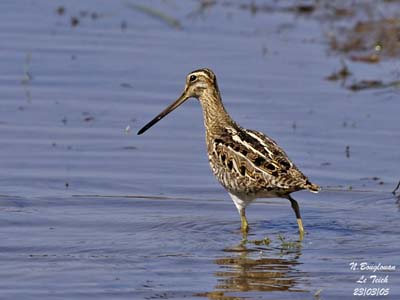
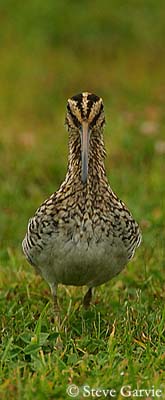
On the underparts, chin and throat are buffy-white. Breast is tinged buffy-brown with darker streaks. Belly and vent are white, but flanks are barred brown.
On the head, crown is dark brown with conspicuous pale stripes. The supercilium is buff. Lores are black. Cheeks and ear-coverts are barred dark brown.
The long, flexible bill is blackish with yellowish base. Eyes are dark brown. Legs and feet are yellow or greyish-green.
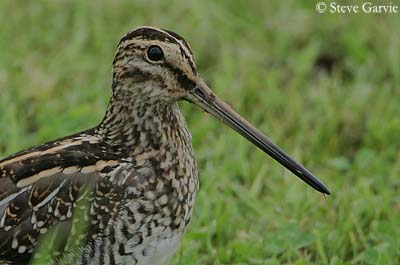
Both sexes are similar.
Juvenile resembles adults, but it has neatly fringed pale buff wing coverts.
We can find three subspecies, G.g. gallinago, G.g. faeroeensis, G.g. delicata, with some variations of plumage colours and pattern.
VOICE: SOUNDS BY XENO-CANTO
Common Snipe utters short, harsh “scaap” or “schkape” when startled. That is their typical flight call.
During the displays, in flight or perched, we can hear a rhythmic “chipper-chipper-chipper-chipper”.
During the dive, the stiff outer tail feathers produce hollow, droning sound.
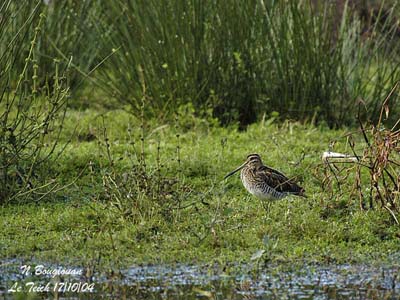
HABITAT:
Common Snipe frequents open fresh or brackish water areas with vegetation, grassy or marshy edges of lakes and streams, wet meadows and marshy tundra. This species needs grassy cover and moist soils providing organic matter.
Outside breeding season, Common Snipe used similar habitats, but it is also found in rice fields, sewage farms, estuaries and coastal meadows.
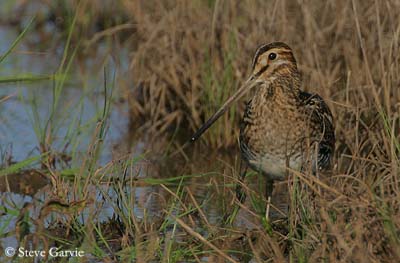
RANGE:
Common Stripe breeds in Iceland, the Faeroes, northern Europe and Russia.
It winters in southern Europe and Africa, and the Asian birds migrate to tropical southern Asia.
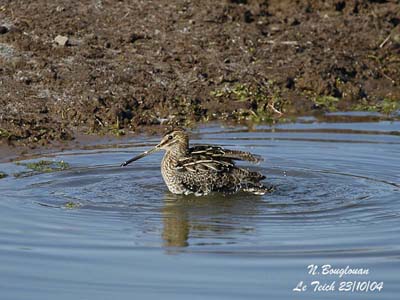
BEHAVIOUR:
Common Snipe feeds in small groups, often at dawn and dusk, in shallow water or close to water. It feeds by probing into the soil, thanks to the long sensitive bill. It performs jabbing movements.
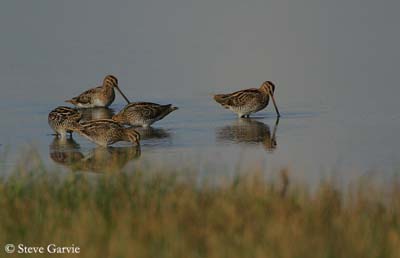
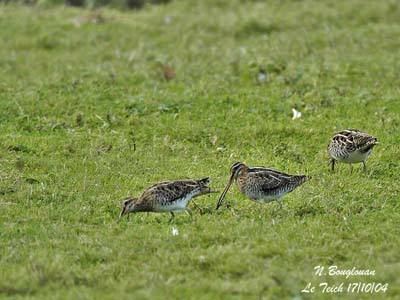
The Snipe remains close to cover, but if alarmed, the bird crouches first, and then, it suddenly flushes with strong wing-beats, flying high and long distance, before to land into cover. During this action, the Snipe gives its harsh call.
The cryptic plumage makes these birds very difficult to observe.
Common Snipe is migratory and winters from south to north tropics.
Some populations are sedentary or partially migratory, such as in Britain when birds from Scandinavia and Iceland join the local populations to enjoy the flooded grasslands providing abundant food sources and vegetation for protection.
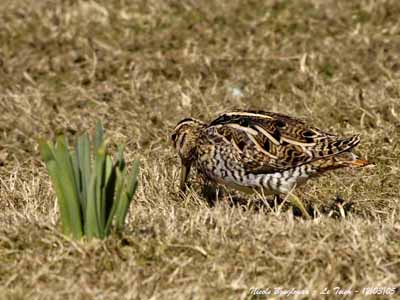
Common Snipe performs flight displays on the breeding grounds. Male performs drumming display and circles high in the air with rapid wing-beats. Then, it dives vertically with stiff outer rectrices, producing a typical drumming sound.
The displaying bird also perches on posts to utter the distinctive “chipper-chipper…” note.
FLIGHT:
In addition to the flight displays, Common Snipe flies in flocks named “wisps”, probably due to the rapid twisting and turning movements before to drop down.
In flight, the Snipe looks rather jerky, performing flickering wing-beats. The wings are pointed triangles, and the long bill is held angled down.
The bird also performs zigzag flight while escaping from predators.
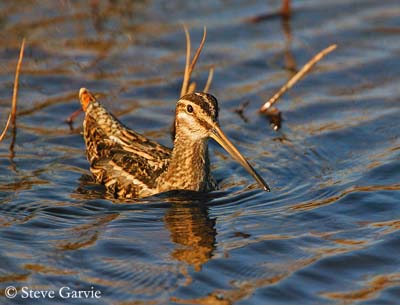
REPRODUCTION:
Common Snipe is monogamous and nests on the ground. The nest is usually situated on dry place. It is covered by grasses or sedges, and among vegetation.
Female lays 4 olive eggs with brown blotches, in April-June. Incubation lasts about 17-20 days by female alone. Chicks have cryptic plumage too.
Both adults feed and care the young. Chicks are fed first bill-to-bill. They fledge 19-20 days after hatching.
As the eggs are on the ground, they often are predated, or trampled by cattle. Parents may produce replacement clutches if necessary.
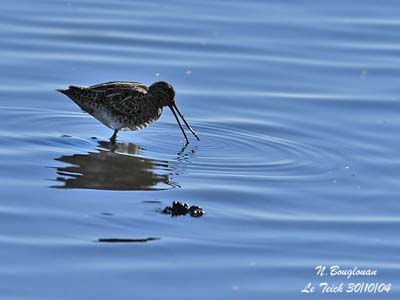
DIET:
Common Snipe feeds on insects (adults and larvae), earthworms, small crustaceans and snails, and spiders. It also takes small quantities of seeds and plant fibres. This species usually feeds in shallow water or close to the water.
